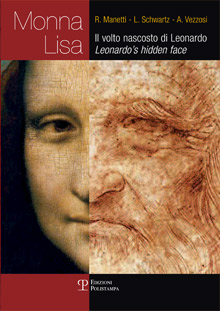Ricerca Veloce
Ricerca Avanzata
chiudi
In this book there are collected the three theories about the most studied and famous painting in history, Leonardo’s Gioconda, expressed during a round table within the event “Genio Fiorentino 2006” [Florentine
The theories which have astonished the world of art in the first International edition released by Florentine publisher Polistampa In this book there are collected the three theories about the most studied and famous painting in history, Leonardo’s Gioconda, expressed during a round table within the event “Genio Fiorentino 2006” [Florentine Genius 2006], promoted by the Province of Florence and entitled “Mona Lisa: The Hidden Face of Leonardo”.
Three scholars and the image under the painting revealed by the X-rays
The three authors offer new interpretations of this masterpiece: Schwartz and Manetti theories’ are based on the firm belief that Mona Lisa is the idealized self portrait of Leonardo; Vezzosi claims that Mona Lisa does not represent Francesco Del Giocondo’s wife, which is contrary to what most of Leonardo’s experts believe.
Lillian Schwartz supplies convincing facts to support her theories: the image under the painting revealed by the X-rays shows a different face from the one that appears on the surface. On the original face, perhaps the portrait of a real woman, Leonardo would have imprinted the actual features until he obtained the painting we know today.
The famous “Gioconda” as an allegory of Leonardo’s mind?
What Lillian does not explain is why Leonardo would have done this. Manetti’s hypothesis supplies an answer to this question, thus strengthening Schwartz’s research. Manetti believes in fact that Mona Lisa, initially conceived as a real portrait, ended up in an ideal image, the iconic talisman of Leonardo’s hidden face, the guiding spirit which the stilnovista tradition allegorically represented with the female angel and, therefore, with the feminine nature.
Alessandro Vezzosi expresses the prudent opinion of the academic world that demands proofs more solid than those offered by the computer. But with his text he provides us with a fascinating and attentive explanation of the Gioconda’s history.
This book, through the reading and the confrontation of these three brief essays, offers itself to the judgment and the close examination of the readers.
Three scholars and the image under the painting revealed by the X-rays
The three authors offer new interpretations of this masterpiece: Schwartz and Manetti theories’ are based on the firm belief that Mona Lisa is the idealized self portrait of Leonardo; Vezzosi claims that Mona Lisa does not represent Francesco Del Giocondo’s wife, which is contrary to what most of Leonardo’s experts believe.
Lillian Schwartz supplies convincing facts to support her theories: the image under the painting revealed by the X-rays shows a different face from the one that appears on the surface. On the original face, perhaps the portrait of a real woman, Leonardo would have imprinted the actual features until he obtained the painting we know today.
The famous “Gioconda” as an allegory of Leonardo’s mind?
What Lillian does not explain is why Leonardo would have done this. Manetti’s hypothesis supplies an answer to this question, thus strengthening Schwartz’s research. Manetti believes in fact that Mona Lisa, initially conceived as a real portrait, ended up in an ideal image, the iconic talisman of Leonardo’s hidden face, the guiding spirit which the stilnovista tradition allegorically represented with the female angel and, therefore, with the feminine nature.
Alessandro Vezzosi expresses the prudent opinion of the academic world that demands proofs more solid than those offered by the computer. But with his text he provides us with a fascinating and attentive explanation of the Gioconda’s history.
This book, through the reading and the confrontation of these three brief essays, offers itself to the judgment and the close examination of the readers.
Data recensione: 22/10/2008
Testata Giornalistica: Artelab
Autore: ––
